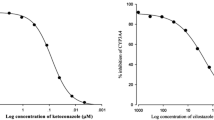Abstract
The aim of this study was to investigate the pharmacokinetic changes of verapamil and its major metabolite, norverapamil, after oral administration of verapamil (10 mg/kg) in rabbits with slight, moderate and severe hepatic failure induced by carbon tetrachloride. The plasma verapamil concentrations in all groups of hepatic failure were significantly higher (p<0.01) than the control. However, the plasma norverapamil concentrations in severe hepatic failure were significantly higher (p<0.05) than the control. The peak concentrations (Cmax) and the areas under the plasma concentration-time curve (AUC) of verapamil in the rabbits were significantly (p<0.01) higher than the control. The absolute bioavailability (FA.B) and the relative bioavailability (FR.B) of verapamil in the rabbits with hepatic failure were significantly higher (13.6-22.2% and 150-244%, respectively) than the control (9.1% and 100%, respectively). Although the AUC and Cmax of its major metabolite, norverapamil, in slight, moderate hepatic failure were not significantly lower than the control, the metabolite-parent AUC ratio in all groups of hepatic failure was decreased significantly (p<0.05, in slight group; p<0.01, in moderate and severe group) than the control. This could be due to decrease in metabolism of verapamil in the liver because of suppressed hepatic function in the hepatic failure groups because verapamil is mainly metabolized in the liver. From our data, it would seem appropriate that in patients with liver disease, doses of verapamil should be decreased by degree of hepatic failure.
Similar content being viewed by others
References
Eichelbaum, M., Remberg, E. G., Schomerus, M., and Dengler, H. J., The metabolism of D, L(14C) verapamil in man.Drug Metab. Dispos., 7, 145–148 (1979).
Eichelbaum, M., Albrecht, M., Kliems, G., Schafer, K., and Somogyi, A., Influence of mesocaval shunt or surgery on verapamil kinetics, bioavailability and response.Brit. J. Clin. Pharmacol., 10, 527–529 (1980).
Eichelbaum, M., Mikus, G., and Vogelgesang, B., Pharmacokinetics of (+)-, (-)-and (±)-verapamil after intravenous administration.Brit. J. Clin. Pharmacol., 17, 453–458 (1984).
Fleckenstein, A., Specific pharmacology of calcium in myocardium, cardiac pacemakers, and vascular smooth muscle.Ann. Rev. Pharmacol. Toxicol., 17, 149–166 (1977).
Freedman, S. B., Richmond, D. R., Ashley, J. J., and Kelly, D. T., Verapamil kinetics in normal subjects and patients with coronary artery spasm.Clin. Pharmacol. Ther., 30, 644–652 (1981).
Gould, B. A., Mann, S., Kieso, H., Bala Subramanian, V., and Raftery, E. B., The 24-hour ambulatory blood pressure profile with verapamil.Circulation, 65, 22–27 (1982).
Krecic-Shepard, M. E., Bamas, C. R., Slimko, J., and Schwartz, J. B., Faster clearance of sustained release verapamil in men versus women: Continuing observations on sex-specific differences after oral administration of verapamil.Clin. Pharmacol. Then, 68, 286–292 (2000).
Lewis, G. R., Morley, K. D., Lewis, B. M., and Bones, P. J., The treatment of hypertension with verapamil.NZ. Medical J., 87, 351–354 (1978).
Rocci, M. L., and Jusko, W. J., LAGRAN program for area and moments in pharmacokinetic analysis.Computer Programs in Biomedicine, 16, 203–209 (1983).
Schomerus, M., Spiegelhaider, B., Stieren, B., and Eichelbaum, M., Physiologic disposition of verapamil in man.Cardiovasc. Res., 10, 605–612 (1976).
Schwartz, J. B., Abernethy, D. R., Taylor, A. A., and Mitchell, J. R., An investigation of the cause of accumulation of verapamil during regular dosing in patients.Brit. J. Clin. Pharmacol., 19, 512–516 (1985).
Somogyi, A., Albrecht, M., Kliems, G., Schafer, K., and Eichelbaum, M., Pharmacokinetics, bioavailability and ECG response of verapamil in patients with liver cirrhosis.Brit. J. Clin. Pharmacol., 12, 51–60 (1981).
Woodcock, B. G., Rietbrock, I., Vohringer, H. F., and Rietbrock, N., Verapamil disposition in liver disease and intensive-care patients: Kinetics, clearance, and apparent blood flow relationships.Clin. Pharmacol. Ther., 29, 27–34 (1981).
Author information
Authors and Affiliations
Corresponding author
Rights and permissions
About this article
Cite this article
Choi, J.S., Burm, J.P. Pharmacokinetics of verapamil and its major metabolite, nor-verapamil from oral administration of verapamil in rabbits with hepatic failure induced by carbon tetrachloride. Arch Pharm Res 28, 483–487 (2005). https://doi.org/10.1007/BF02977680
Received:
Issue Date:
DOI: https://doi.org/10.1007/BF02977680




